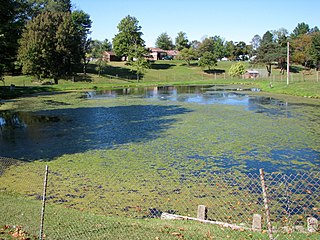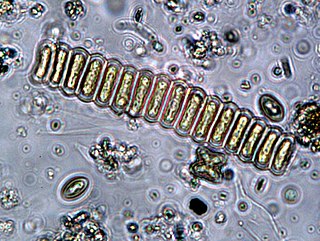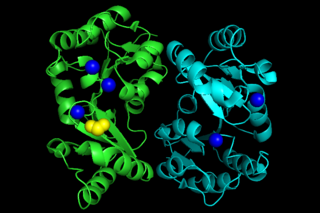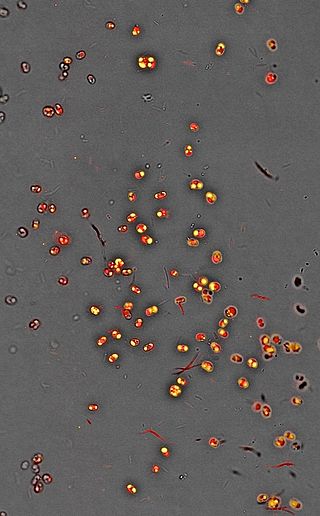Related Research Articles

Pyrenoids are sub-cellular micro-compartments found in chloroplasts of many algae, and in a single group of land plants, the hornworts. Pyrenoids are associated with the operation of a carbon-concentrating mechanism (CCM). Their main function is to act as centres of carbon dioxide (CO2) fixation, by generating and maintaining a CO2 rich environment around the photosynthetic enzyme ribulose-1,5-bisphosphate carboxylase/oxygenase (RuBisCO). Pyrenoids therefore seem to have a role analogous to that of carboxysomes in cyanobacteria.

Chlamydomonas reinhardtii is a single-cell green alga about 10 micrometres in diameter that swims with two flagella. It has a cell wall made of hydroxyproline-rich glycoproteins, a large cup-shaped chloroplast, a large pyrenoid, and an eyespot apparatus that senses light.

Microalgae or microphytes are microscopic algae invisible to the naked eye. They are phytoplankton typically found in freshwater and marine systems, living in both the water column and sediment. They are unicellular species which exist individually, or in chains or groups. Depending on the species, their sizes can range from a few micrometers (μm) to a few hundred micrometers. Unlike higher plants, microalgae do not have roots, stems, or leaves. They are specially adapted to an environment dominated by viscous forces.

Snow algae are a group of freshwater micro-algae that grow in the alpine and polar regions of the Earth. Snow algae have been found on every continent but are restricted to areas with temperatures between 0°C-10°C. Snow algae are pigmented by chlorophyll and carotenoids and can be a variety of colors depending on the individual species, life stage, and topography/geography. The pigmentation of snow algae reduces snow and ice albedo, which can stimulate the melting of perennial snow and ice and exacerbate the effects of climate change. Snow algae are primary producers that form the basis of communities on snow or ice sheets that include microbes, tardigrades, and rotifers. Snow algae have also been carried great distances by winds.

Chlamydomonas nivalis, also referred to as Chloromonas typhlos, is a unicellular red-coloured photosynthetic green alga that is found in the snowfields of the alps and polar regions all over the world. They are one of the main algae responsible for causing the phenomenon of watermelon snow, where patches of snow appear red or pink. The first account of microbial communities that form red snow was made by Aristotle. Researchers have been active in studying this organism for over 100 years.
The Aquatic Species Program was a research program in the United States launched in 1978 by President Jimmy Carter and was funded by the United States Department of Energy, which over the course of nearly two decades looked into the production of energy using algae. Initially, the funding of the Aquatic Species Program was to develop renewable fuel for transportation. Later, the program focused on producing bio-diesel from algae. The research program was discontinued in 1996. The research staff compiled their work and conclusions into a 1998 report.

Biohydrogen is H2 that is produced biologically. Interest is high in this technology because H2 is a clean fuel and can be readily produced from certain kinds of biomass, including biological waste. Furthermore some photosynthetic microorganisms are capable to produce H2 directly from water splitting using light as energy source.

Algal nutrient solutions are made up of a mixture of chemical salts and seawater. Sometimes referred to as "Growth Media", nutrient solutions, provide the materials needed for algae to grow. Nutrient solutions, as opposed to fertilizers, are designed specifically for use in aquatic environments and their composition is much more precise. In a unified system, algal biomass can be collected by utilizing carbon dioxide emanating from power plants and wastewater discharged by both industrial and domestic sources. This approach allows for the concurrent exploitation of the microalgae's capabilities in both carbon dioxide fixation and wastewater treatment. Algae, macroalgae, and microalgae hold promise in addressing critical global challenges. Sustainable development goals can be advanced through algae-based solutions, to promote a healthy global ecosystem.

Scenedesmus is a genus of green algae, in the class Chlorophyceae. They are colonial and non-motile. They are one of the most common components of phytoplankton in freshwater habitats worldwide.
Auxenochlorella protothecoides, formerly known as Chlorella protothecoides, is a facultative heterotrophic green alga in the family Chlorellaceae. It is known for its potential application in biofuel production. It was first characterized as a distinct algal species in 1965, and has since been regarded as a separate genus from Chlorella due its need for thiamine for growth. Auxenochlorella species have been found in a wide variety of environments from acidic volcanic soil in Italy to the sap of poplar trees in the forests of Germany. Its use in industrial processes has been studied, as the high lipid content of the alga during heterotrophic growth is promising for biodiesel; its use in wastewater treatment has been investigated, as well.

Algae fuel, algal biofuel, or algal oil is an alternative to liquid fossil fuels that uses algae as its source of energy-rich oils. Also, algae fuels are an alternative to commonly known biofuel sources, such as corn and sugarcane. When made from seaweed (macroalgae) it can be known as seaweed fuel or seaweed oil.

Phosphoglycolate phosphatase(EC 3.1.3.18; systematic name 2-phosphoglycolate phosphohydrolase), also commonly referred to as phosphoglycolate hydrolase, 2-phosphoglycolate phosphatase, P-glycolate phosphatase, and phosphoglycollate phosphatase, is an enzyme responsible for catalyzing the conversion of 2-phosphoglycolate into glycolate and phosphate:
TerraVia Holdings, Inc. was a publicly held biotechnology company in the United States. TerraVia used proprietary technology to transform a range of low-cost plant-based sugars into high-value oils and whole algae ingredients. TerraVia supplied a variety of sustainable algae-based food ingredients to a number of brands, which included Hormel Food Corporation, Utz Quality Foods Inc and enjoy Life Foods. TerraVia also sold its own culinary algae oil under the Thrive Algae Oil brand. In 2017, the firm declared bankruptcy.

Nannochloropsis is a genus of algae comprising six known species. The genus in the current taxonomic classification was first termed by Hibberd (1981). The species have mostly been known from the marine environment but also occur in fresh and brackish water. All of the species are small, nonmotile spheres which do not express any distinct morphological features that can be distinguished by either light or electron microscopy. The characterisation is mostly done by rbcL gene and 18S rRNA sequence analysis.
The Gilbert Morgan Smith Medal is awarded by the U.S. National Academy of Sciences "in recognition of excellence in published research on marine or freshwater algae." It has been awarded every three years since 1979.

Nannochloropsis is a genus of alga within the heterokont line of eukaryotes, that is being investigated for biofuel production. One marine Nannochloropsis species has been shown to be suitable for algal biofuel production due to its ease of growth and high oil content, mainly unsaturated fatty acids and a significant percentage of palmitic acid. It also contains enough unsaturated fatty acid linolenic acid and polyunsaturated acid for a quality biodiesel.

Microalgae or microscopic algae grow in either marine or freshwater systems. They are primary producers in the oceans that convert water and carbon dioxide to biomass and oxygen in the presence of sunlight.
Sammy Boussiba is a professor emeritus at the French Associates Institute for Agriculture and Biotechnology of Drylands at the Jacob Blaustein Institutes for Desert Research at Ben-Gurion University of the Negev, Israel.
Alison Gail Smith, Lady Hopper is Professor of Plant Biochemistry in the Department of Plant Sciences at the University of Cambridge, UK. Her research investigates the metabolism of plants, algae and bacteria, in particular vitamin and cofactor biosynthesis.
References
- 1 2 Pollock, Steve (December 2003). "Rubisco Activase is Required for Optimal Photosynthesis in the Green Alga Chlamydomonas reinhardtii in a Low-CO2 Atmosphere". Plant Physiology. 133 (4): 1854–1861. doi:10.1104/pp.103.032078. PMC 300738 . PMID 14605215.
- ↑ "Algae-Based Biofuels". Archived from the original on 2012-10-24.
- ↑ Adams, James (May 2004). MOLECULAR, GENETIC AND PHYSIOLOGICAL CHARACTERIZATION OF A CHLAMYDOMONAS REINHARDTII INSERTIONAL MUTANT (PhD thesis). Louisiana State University. ProQuest 305172134.
- ↑ Bailey, Michael (October 2012). "Personal Interview".
{{cite journal}}: Cite journal requires|journal=(help) - ↑ Reeves, Jacqueline (2005). "Emerging Drug Targets for Antiretroviral Therapy". Drugs. 65 (13): 1747–1766. doi:10.2165/00003495-200565130-00002. PMID 16114975. S2CID 32730604.
- ↑ "Algae-Based Biofuels--Oil's REal Replacement". May 2009.
{{cite journal}}: Cite journal requires|journal=(help)